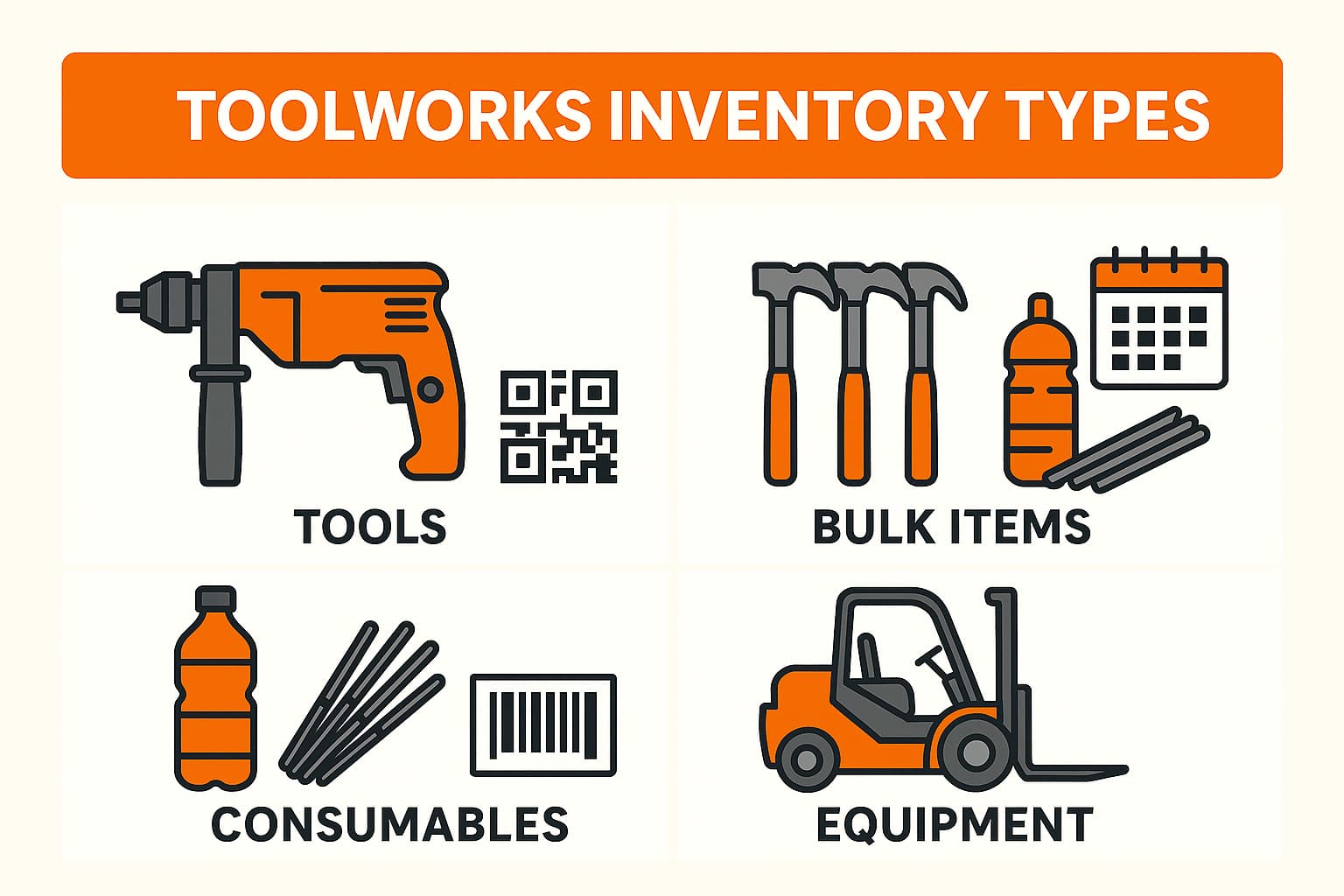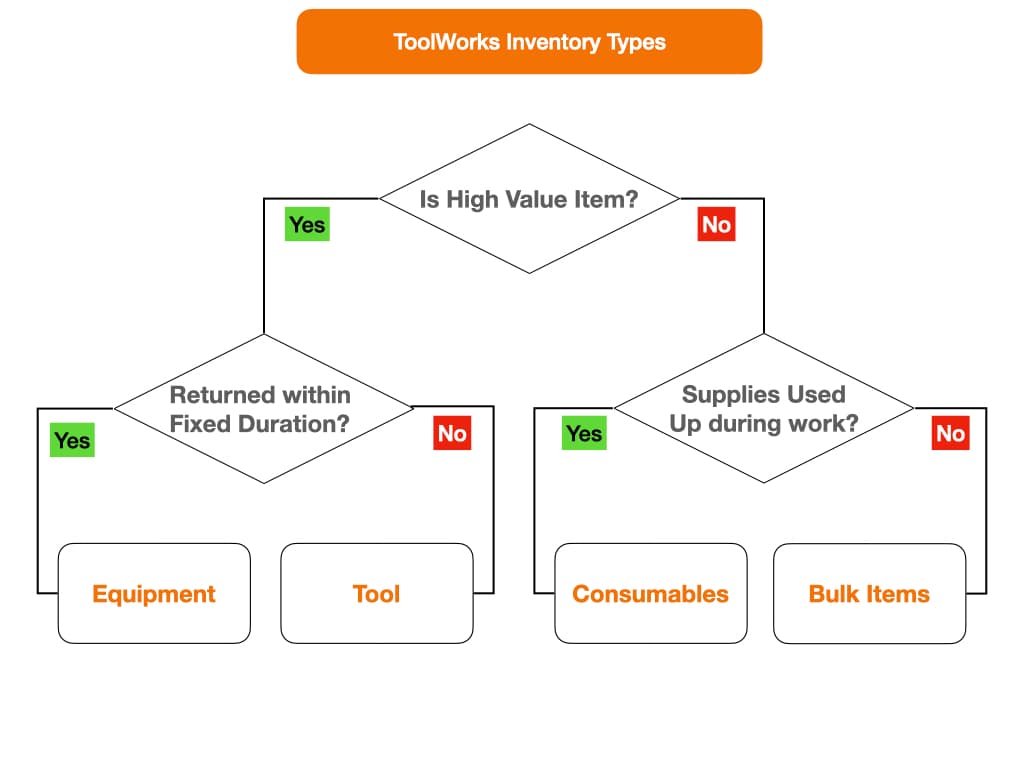ToolWorks Inventory Types Guide
How to Choose the Right ToolWorks Inventory Type for Better Asset Management
Start Tracking NowToolWorks makes it easy to track tools, equipment, supplies, and materials — but choosing the right inventory type is key to effective management. In this guide, we'll walk you through the four inventory types in ToolWorks, explain how they work, and help you decide which one is right for your assets.
What are the Inventory Types in ToolWorks?
ToolWorks supports four inventory types to help you manage tools and assets efficiently: Tools, for high-value serialized items; Bulk Items, for group-tracked tools; Consumables, for supplies that are used up over time; and Equipment, for high-value assets reserved for a fixed period. Choosing the right inventory type improves tool tracking, inventory management, and asset utilization.
ToolWorks Inventory Types:
- Tools: High-value items tracked individually.
- Bulk Items: Group-tracked tools with shared barcode.
- Consumables: Supplies consumed over time and removed from stock.
- Equipment: High-value assets reserved for fixed periods.
When adding a new Tool, one of the important things to consider is the inventory type. ToolWorks supports four different types of inventory items: Tools, Bulk Items, Consumables, and Equipment.

Lets look at each of them in detail, how they are used and how they differ from each other.
1. Tools
Tools are high-value items that you want to track individually. Each tool is assigned a unique barcode or QR code, creating a digital fingerprint for easy tracking. Tools are often assigned to users for long periods and must be returned after use. They are sometimes called Serialized Items or Assets.
With ToolWorks, you can:
- Assign tools to users
- Transfer tools to job sites
- Check tools in and out
- Track maintenance, purchases, and audits
Examples: Hammer Drill, Miter Saw.
ToolWorks makes sure that the location and custodianship of each tool is meticulously tracked and monitored, allowing you to trace it back to the responsible individual and location. With individual tracking, you can keep a watchful eye on the whereabouts of these critical assets. And when the job is done, ToolWorks helps you ensure that each tool is returned and accounted for.
2. Bulk Items
Bulk items are assets that are tracked in group rather than individually. They are also referred to "Quantity Items". Instead of each item having unique barcode, all items in the group have same barcode or qr code. Unlike Tools, Bulk Items are not tracked individually but still require return after use.
Bulk Items are perfect for:
- Tools that are valuable but not serialized
- Easier check-in/check-out for groups
- Faster inventory management
Examples: Shovels, standard hammers.
Like Tools, Bulk Items can be checked out, transferred, maintained, purchased, and audited — just managed more efficiently in bulk.
3. Consumables
Consumables are materials or supplies that are used up or consumed over time and permanently removed from inventory once utilized.
Consumable items include:
- Welding rods
- Water bottles
- Gloves
ToolWorks tracks consumables as a group, reducing manual work. You can also configure how long consumables stay associated with a user before they are removed from stock (defaults to 8 days but customizable).
Enterprise users can fine-tune this per item using the "Consumable Days" setting.
4. Equipment
Equipment are high-value assets that require individual tracking, like Tools, but with a fixed reservation period. These items are reserved, used, and returned within specific timeframes.
Examples: Forklift, Scissor lift.
When assigning Equipment in ToolWorks:
- Start date and return date are required.
- Equipment can represent assets that either move or stay reserved at a location.
ToolWorks tracks all key Equipment activities: reservations, transfers, check-ins, maintenance, purchases, and audits.
How to Choose the Right Inventory Type
Choosing the correct inventory type in ToolWorks improves asset management, boosts efficiency, and reduces errors.
Here’s a simple guide:
| Criteria | Inventory Type |
|---|---|
| High-Value, Individually Tracked, Long-Term | Tools |
| High-Value, Reserved for Fixed Time | Equipment |
| Used-Up Supplies or Materials | Consumables |
| Tracked in Bulk Quantity | Bulk Items |

Can I Change the Inventory Type Later?
Yes! ToolWorks allows you to change the inventory type if needed — with some simple rules:
- Tools ↔ Equipment: Can be changed freely.
- Bulk Items ↔ Consumables: Can be changed freely.
- Tools → Bulk Items/Consumables: Allowed if there's only one item in the group.
- Bulk Items/Consumables → Tools/Equipment: Allowed if there's only one item in the group.
You can update the inventory type directly from the asset details page.
Conclusion
Choosing the right inventory type is crucial for efficient tool tracking and inventory management. Whether you're managing serialized Tools, high-value Equipment, grouped Bulk Items, or Consumable supplies, ToolWorks gives you the flexibility and control you need to keep your assets organized, available, and in top condition. By understanding how each inventory type works, you can streamline your operations, reduce losses, and maximize the value of your tools and equipment.
Ready to take control of your inventory? 👉 Get started with ToolWorks today!